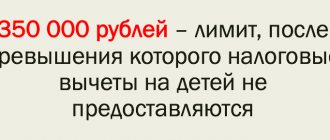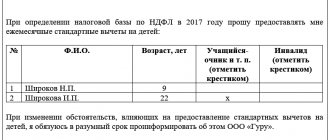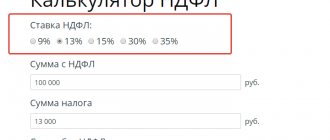kod_vycheta_134_v_spravke_2-ndfl.jpg
Related publications
To reflect the income accrued to an individual and the tax withheld from him, a special form has been developed - Certificate 2-NDFL. In addition to earnings, the certificate shows deductions that reduce the tax base. Each amount is indicated along with a code indicating the name of the income or deduction. You can find out the decoding from special reference books. Let us explain in what cases deduction code 134 is entered in 2-NDFL.
Online magazine for accountants
This is a universal code that serves as a lifeline for deductions that do not fit into the main existing codes. Code 620 means “Other amounts that reduce the tax base in accordance with the provisions of Chapter 23 “Personal Income Tax.” That is, it turns out that when deductions are not indicated in Appendix 2 to the order of the Federal Tax Service of Russia No. ММВ-7-11/387 and in the Decree of the Government of the Russian Federation of October 24, 2017 No. ММВ-7-11/ the accountant can safely enter the code 2-NDFL into the certificate 620. The Tax Code of the Russian Federation allows for such manipulations. No matter how carefully they pay attention to the documents, no one has canceled the human factor, so there is a high risk that in 2-NDFL you will indicate the deduction code incorrectly.
Firstly, to prevent this from happening, carefully look at the table of personal income tax deduction codes with explanations presented above.
Amount and period of deduction
The standard deduction for a single parent (adoptive parent) is 2,800 rubles. per month (this is double the amount, applied on the basis of clause 4, clause 1, article 218 of the Tax Code of the Russian Federation). It is provided by:
until the end of the year in which the child became 18 years old;
until the month of graduation (full-time) or until the end of the year in which the student reached the age of 24;
until the parent enters into a new marriage.
We will show the procedure for providing a deduction to a single parent using examples.
Example 1. Excess of income
Example 2. Providing a deduction for a student
Example 3: Getting married
She was provided with a double standard deduction under code 134 from January to February in the amount of 5,600 rubles. (2800 rub. x 2 months = 5600 rub.). Starting in March, the employee is entitled to a standard deduction of 1,400 rubles. (code 126), since she has ceased to be the only parent, but the child is still supported by the mother.
This is important to know: personal income tax on bonuses: payment procedure in 2021
New deduction code 128 for 2-NDFL certificates
It is also worth noting that this code also hides the fourth, fifth child, and so on. This code, which carries a deduction of three thousand, is suitable for those who have three or more children. The new deduction code 128 replaces code 116, which, like many others, was replaced at the end of 2021.
It is worth highlighting that if an employee has three children, each of whom is not older than 24 years old and is studying at a university, then the total deduction amount will be 5,800 rubles. This allows you to save 754 rubles monthly. Over the course of a year, a good amount is obtained, which ends up in the employee’s pocket, and is not transferred to the tax authorities.
Standard tax deduction per taxpayer
This standard tax deduction is provided to certain categories of citizens in relation to income subject to personal income tax at a rate of 13% (except for income from equity participation in organizations).
In addition, you must have tax resident status.
As a general rule, such persons are recognized as persons who are actually in the Russian Federation for at least 183 calendar days over the next 12 consecutive months (clause 2 of Article 207, clause 3 of Article 210, clauses 1, 2, clause 1 of Article 218, p. 1 Article 224 of the Tax Code of the Russian Federation).
List of persons entitled to a standard tax deduction
Citizens entitled to a standard tax deduction include, in particular (clauses 1, 2, clause 1, article 218 of the Tax Code of the Russian Federation):
1) participants of the Great Patriotic War;
2) disabled people since childhood, disabled people of groups I and II;
3) citizens who have received or suffered diseases associated with radiation exposure caused by the consequences of radiation accidents at nuclear facilities;
4) parents and spouses of military personnel who died as a result of wounds, contusions or injuries they received while defending the USSR and the Russian Federation.
Amount of standard tax deduction
If an individual has the right to a deduction for several reasons, then only the largest of them is provided (Article 216, paragraph 2 of Article 218 of the Tax Code of the Russian Federation).
Deduction code for a child in 2021 in the 2-NDFL certificate
Despite the fact that the deduction amount for one child and for the second child is the same, you cannot add up these deductions and indicate them as a single amount in 2-NDFL at once, as for two children. The deduction codes in this and similar situations will be different - 126 and 127.
Company employees who have children are entitled to a tax deduction. It reduces the personal income tax base. This is the so-called standard tax deduction. But in addition to the standard ones, there are also property, social and other deductions. To make it clear from the 2-NDFL certificate by which deduction the tax base from the employee’s income was reduced, each type of deduction is assigned its own code.
Standard child tax deduction
The child's parents, who support him, have the right to receive a standard personal income tax deduction (deduction for children) on a monthly basis.
A tax deduction allows you to reduce income subject to personal income tax at a rate of 13% (except for income from equity participation in an organization) by a certain amount.
That is, personal income tax will be paid on a smaller amount.
To take advantage of the deduction, parents must have tax resident status and income that is subject to personal income tax at a rate of 13%, for example, receive wages (clause 3 of Article 210, clause 4 of clause 1 of Article 218 of the Tax Code of the Russian Federation).
What age is the standard tax deduction available for children?
A standard deduction is provided for each child (clause 4, clause 1, article 218 of the Tax Code of the Russian Federation):
- from 18 to 24 years old, studying full-time in the Russian Federation or abroad (pupil, student, cadet, intern, graduate student, resident), incl. with paid training.
Who is eligible for the standard tax deduction?
A personal income tax deduction for a child can be provided to an employee (including GPA and external part-time worker) who:
is a tax resident of the Russian Federation;
has a child to support;
submitted your application for a deduction.
Amount of standard tax deductions
The amount of the deduction depends on which account of the child it is provided for (clause 4, clause 1, article 218 of the Tax Code of the Russian Federation).
The order of birth of children is determined by their dates of birth.
In this case, those children are also taken into account for whom a deduction is not provided, for example, because the child is over 18 years old and is not studying full-time.
Who is the deduction for?
For the first or second child
For the third and each subsequent child
The amount of the deduction for a disabled child depends on who receives the deduction and is added to the deduction depending on the order of birth of the child.
Who is entitled to the deduction?
For the first or second child
For the third and each subsequent child
Parent, his spouse, adoptive parent
Guardian, trustee, adoptive parent, his spouse (husband)
Thus, a tax deduction is provided for each child in an amount that depends on the number of children in the family, namely:
This is important to know: Personal income tax upon dismissal: purpose of payment, sample
1,400 rub. – for the first child;
1,400 rub. – for the second child;
3,000 rub. – for the third and each subsequent child.
Providing a standard double tax deduction
A double deduction for a child is provided (clause 4, clause 1, article 218 of the Tax Code of the Russian Federation):
single parent (including adopted), adoptive parent, guardian, trustee;
to a parent (including an adoptive one) when the second adoptive parent refused the deduction.
Limitations on the provision of a standard tax deduction
When providing a deduction, the following are taken into account (paragraph 11, 16, 17, paragraph 4, paragraph 1, article 218 of the Tax Code of the Russian Federation):
2. Age of the child: as a general rule, you can receive a deduction for children under the age of 18 inclusive. However, the period for receiving the deduction is extended until the child reaches 24 years of age if he is a full-time student, student, graduate student, resident or intern.
The tax agent organization paid the taxpayer, who is a tax resident of the Russian Federation, the following income:
The employee is entitled to standard tax deductions for two children in the amount of 1,400 rubles. for the first child and 1400 rubles. - for the second child.
Amounts of deductions for children
The deduction amounts are currently as follows:
— for the first and second child — 1,400 ₽
— for the third and each subsequent — 3,000 ₽
Children are counted regardless of age. For example, an employee has three children. Two are already adults: 25 years old and 23 years old, and the third is 16 years old. An employee is entitled to one deduction for a third child - 3,000 rubles.
There are more deductions for disabled children:
— for parents and adoptive parents — 12,000 ₽
— for guardians, trustees, foster parents — 6,000 ₽
It does not matter what type of disabled child is in the family. You can also add general deductions for children. For example, for an only disabled child, the deduction will be 13,400 rubles. After all, parents are entitled to a deduction for their first child - 1,400 rubles and for a disabled child - 12,000 rubles.
Important: provide a standard tax deduction for a child until the month in which the employee’s income from the beginning of the year exceeds 350,000 rubles.
Interesting fact
If a child grows up quickly and gets married, then you can no longer get a deduction for him - now he provides for himself. But if he decides to try his hand at work, then his parents still have the right to a deduction. In general, marriage is a responsible matter :)
Obtaining a standard tax deduction from the employer
To receive a tax deduction for children, you need to contact your employer with an application for a personal income tax deduction and documents confirming the right to the deduction (clause 3 of Article 218 of the Tax Code of the Russian Federation).
Such documents, in particular, are:
child's birth or adoption certificate (if the child was adopted);
marriage registration certificate;
certificate of disability (if the child is disabled);
a certificate from the educational institution where the child is studying (if the child is over 18 years old);
an agreement on the payment of alimony or a writ of execution (court order) on the transfer of alimony for child support (if the parent pays alimony);
a parent’s receipt stating that the second parent applying for the deduction is involved in providing for the child. This is necessary if the parents are not married, but the other parent provides for the child, although does not pay child support.
Deduction code 118 in personal income tax certificate 2
Each employee may receive certain child tax credits. Moreover, the order of birth of children in this case is determined solely by dates. Also taken into account are those children for whom the deduction is no longer provided. That is, if there is a child 18 years old in the family, then deductions are made for the second child, as for the second child born in the family.
That is, deductions apply to any type of income - wages, permanent payments, financial assistance, benefits, etc. Also, all these types of income will be summed up until the total amount exceeds the established limit. After which, tax deductions will not be used.
Obtaining a standard tax deduction from the tax office
If your employer did not provide you with a deduction or provided it in a smaller amount, then at the end of the year you can apply for a deduction to the tax office at your place of residence (clause 4 of Article 218 of the Tax Code of the Russian Federation).
To do this, you need to submit to the inspection:
tax return in form 3-NDFL for the year in which the deduction was not provided or was provided in a smaller amount;
copies of documents confirming the right to deduction;
application for a refund of overpaid tax to a bank account;
certificate of income for the past year in form 2-NDFL.
The tax inspectorate must check the declaration and documents within three months from the date of their submission (clause 2 of article 88 of the Tax Code of the Russian Federation).
If the right to deduction is confirmed and the fact of overpayment of personal income tax is confirmed, the corresponding amount of overpayment is subject to refund within a month from the date of receipt of the application for tax refund or the end of the desk audit, if the application was submitted along with the declaration.
Still have questions about accounting and taxes? Ask them on the accounting forum.
Deduction code 126 in the 2-NDFL certificate
Standard tax deductions provided for in Article 218 of the Tax Code of the Russian Federation For the first child under the age of 18, as well as for each full-time student, graduate student, resident, intern, student, cadet under the age of 24 to a parent, spouse of a parent , the adoptive parent who is providing for the child.
For example, according to the 2-personal income tax certificate in paragraph 4, the employee filled out deduction code 126 in the amount of 5,600 rubles. The declaration is filled out to refund training taxes; the amount of expenses for these purposes amounted to 38,000 rubles. The employee, therefore, claims a refund of 13%, that is, 4,940. But if he forgets to reflect the deduction in the amount of 5,600 in the declaration, then the amount of tax refund will be calculated as follows: 38,000 * 0.13 - 5,600 * 0.13 = 4,212.










